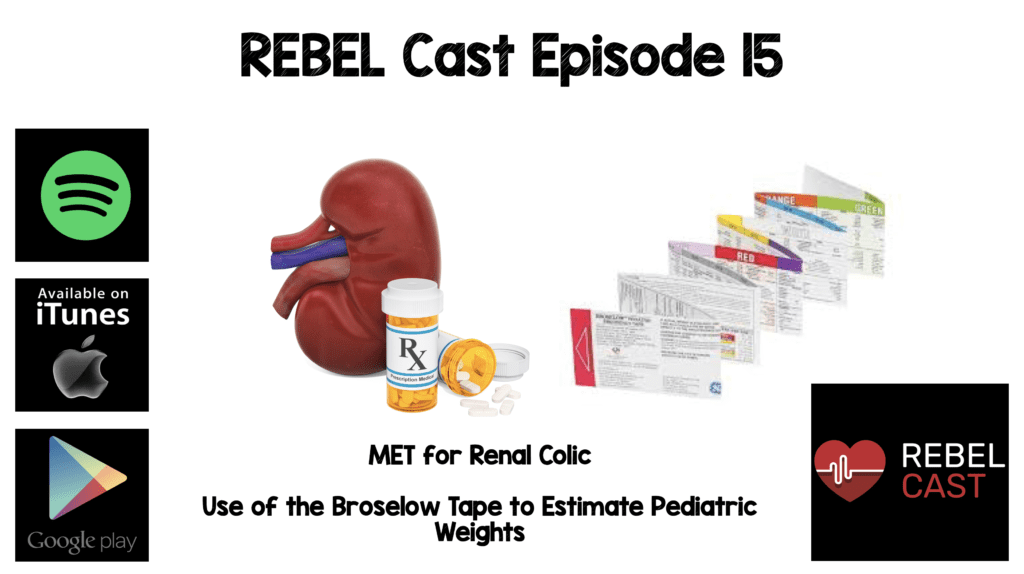
Topic #1: MET for Renal Colic
Topic #2: Use of the Broselow Tape to Estimate Pediatric Weights
REBEL Cast Episode 15: MET for Renal Colic & Use of Broselow Tape to Estimate Pediatric Weights
Click here for Direct Download of Podcast
Topic #1: MET for Renal Colic
Background:Ureteric (renal) colic is a common, painful condition encountered in the Emergency Department (ED). Sustained contraction of smooth muscle in the ureter as a kidney stone passes the length of the ureter leads to pain. The majority of stones will pass spontaneously (i.e. without urologic intervention). For over a decade, calcium channel blockers (i.e. nifedipine) and, more commonly, alpha adrenoreceptor antagonists (i.e. tamsulosin) have been employed in the treatment of ureteric colic for their potential ability to increase stone passage, reduce pain medication use and reduce urologic interventions. The physiologic basis for treatment with these agents is that they reduce spasm. The use of these medications was based on poor methodologic studies and meta-analyses of these flawed studies. A number of randomized trials performed over the last 6 years have not been as supportive. However, these studies were small and had flaws of their own. The question of whether medical expulsion therapy (MET) is beneficial remains.
What They Did:
- Randomized 1136 patients to one of three arms: placebo, once daily nifedipine (30 mg) or once daily tamsulosin (400 mcg).
- Multicenter, double-blind, placebo controlled
Patient Population:
- Inclusion Criteria
- Adults aged 18-65
- Single kidney stone < 10 mm identified on CT or KUB
- Exclusion Criteria
- Patients requiring immediate urologic intervention
- An estimated GFR < 20 ml/min
- Patients already taking or unable to take tamsulosin or nifedipine
Outcomes:
- Primary Endpoint
- Need for urologic intervention to facilitate stone passage at 4 weeks after randomization
- Secondary Endpoints (At Hospital Discharge & 6 Months)
- Number of days of analgesic use
- Visual analog scale at 4 weeks
- Time to stone passage
- Health status
- Safety assessed by participant report of discontinuation due to adverse events or serious adverse events monitoring
Results:
- 1167 patients randomized. 17 patients excluded after randomization due to prior set exclusions
- Primary Outcome:
- Placebo (20%) vs. Tamsulosin (19%) vs. Nifedipine (20%)
- No statistically significant difference
- Secondary Outcomes:
- No difference in analgesic use
- No difference in time to stone passage
- No difference in health status
Limitations:
- Stone passage not documented, only absence of further intervention
- Only 25% of stones were large (> 5 mm)
Discussion:
- This study is the largest, well-done randomized trial looking at the efficacy of MET in renal colic and supports the findings of the majority of recent smaller studies that did not demonstrate a benefit to the use of tamsulosin.
- There may be a subgroup of patients that will benefit from MET. The authors performed an unplanned secondary analysis demonstrating a small benefit to distal ureteral stones (where receptors are more concentrated). Others have argued that large stones would see a greater benefit. It’s important to note that taking advantage of these subgroup benefits would likely require advanced imaging, which, we are attempting to reduce in renal colic patients.
Study Conclusion: “Tamsulosin 400 μg and nifedipine 30 mg are not effective at decreasing the need for further treatment to achieve stone clearance in 4 weeks for patients with expectantly managed ureteric colic.”
Reference:
Pickard R et al. Medical expulsive therapy in adults with urteric colic: a multicenter, randomized, placebo-controlled trial. Lancet 2015. PMID: 25998582
Topic #2: Use of the Broselow Tape to Estimate Pediatric Weights
Background: In pediatric emergencies and resuscitation it is important to have an accurate estimate of a child’s weight. Many including myself, use the Broselow Tape (BT), which was developed in the late 1980s, to help with drug dosages and equipment size. More than 30 years later the World Health Organization referred to obesity as a global pandemic. In Canada research has shown that the rates of obesity and overweight children has more than doubled in recent decades with more than one in three children considered overweight or obese. In light of the increasing obesity rates, the BT may actually underestimate children’s weight and more importantly has not been revalidated in light of the childhood obesity epidemic.
Question: In the era of epidemic obesity in children, is the Broselow Tape (BT) still a reliable tool to estimate the weight of children?
Article: Milne WK et al. Ontario children have outgrown the Broselow tape. CJEM 2012; 14(1): 25-30. PMID: 22417954
What they did:
- Prospective observation cohort study including 6,361 children in Ontario, Canada.
- Compared actual weights vs. weight estimates using BT (2002A)
Results:
- 6,361 children
- 2% female
- Median age 3.9 years
- Median weight 17.2 kg
- Median height 103.5cm
- Overall, good correlation between BT and actual weight (p<0.0001)
- Found 7.1% bias to underestimate actual weight (Used percent error of 10% to signify significance)
- 7% of weights were found to have ≥10% percent error (This did not reach statistical significance)
Strengths:
- Variety of settings where children’s measurements were collected
- Over 6,000 children measured, which is the largest study ever performed to validate the BT in Canada
Limitations:
- Children in the rural population did not have the age in months recorded
- The assumption that this particular cohort of young healthy children has the same weight as a population of children requiring resuscitation
Discussion:
- Pediatric Advanced Life Support (PALS) guidelines recommend a dose of 0.01mg/kg of epinephrine when indicated by IV or IO routes and /or three shocks of increasing intensity (2, 2 – 4, and 4 J/kg). Based on this study, children from Ontario are at risk of under dosing, which could affect the success of resuscitation
Clinical Bottom line:
The Broselow tape remains a good estimate of weight in pediatric patients, but it is just that, an estimate. With the growing population of overweight and obese children, there is a very real chance the BT will underestimate the actual weight. This has the potential for clinical consequences, such as under dosing of medications and using equipment that is too small.
For more on what others thought on these topics checkout:
MET for Renal Colic
- Ryan Radecki at EM Lit of Note: Finally, an End to Tamsulosin for Renal Colic?
- Anand Swaminathan at REBEL EM: Does Use of Tamsulosin in Renal Colic Facilitate Stone Passage?
- Anand Swaminathan at REBEL EM: Medical Expulsion Therapy in Ureteral Colic – An Update
Post Peer Reviewed By: Anand Swaminathan (Twitter: @EMSwami)



